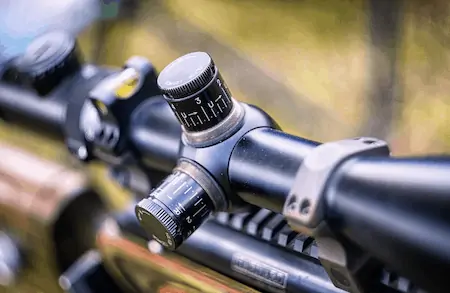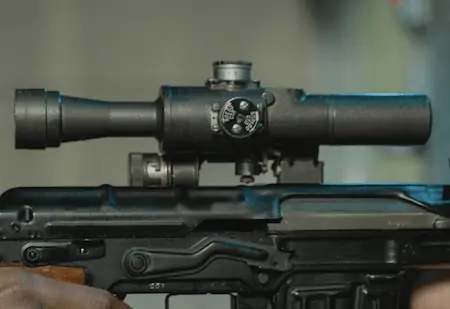The rifle scope magnifies the target by a certain amount. What is that number, and how can you find it?
It is a very simple question to answer. You can find the specifications of a rifle scope inscribed in the scope itself or on its package.
However, sometimes the numbers can seem daunting, and you might struggle to understand them.
Not to worry! We have done the work for you.
Keep on reading the article to find the answer to what do the numbers on a rifle scope mean.
A Little About Rifle Scope
The riflescope is arguably the most important part of a rifle as it helps one aim at the target located at a distance. It allows you to zoom in on your target and take a proper aim.
The scope comes with marked numbers that show you how much you have magnified an object and what angle the target is situated in.
Different Types of Scopes
There are two types of rifle scopes in the market. One of them is called the variable scope, which is popularly known as an adjustable scope. The other one is called the fixed scope.
As the name suggests, fixed scope allows no adjustment. On the contrary, the variable scope is very versatile as it provides enough wiggle room but within an allotted range. You will find that markings on both types of scopes.
What Do the Numbers In a Rifle Scope Define?
What do the numbers etched into the rifle scope represent?
In simple terms, they represent the magnification power and the diameter of a lens. Apart from that, the lens also has additional numbers.
Let’s take an in-depth look into what the numbers inscribed in the rifle scope mean.
Variable Rifle Scope
In a rifle scope, you will see that along with inscribed numbers, other letters are written as well. A variable scope will have the markings VO. Another thing that indicates your rifle scope is a variable scope is if it has a three-number format.
You can locate an adjustment ring that allows you to maneuver between the allotted range.
When you take a closer look at the variable rifle scope at hand, you will find three numbers written in them that specify three different things.
Two of the numbers indicate the extent to which you can zoom an object, while the other number specifies the width of the objective lens.
For example, take a scope with a 3- 9x 40 mm inscription. Here, 3 shows the least amount you can magnify, 9 shows the most magnification power, and 40 mm demonstrates the width of the objective lens you are operating.
Hence, we can deduce that these numbers are displaying the rate at which you can magnify the object.
Over here, three means the object is magnified three times, and nine means the thing is magnified by nine times, which means that your range of magnification will allow you to zoom in between three to nine times.
However, this range is not fixed. Riflescopes come in a wide range of numbers. The larger the number, the more you can magnify, but that does not come cheap. The higher the range of the scope and the higher number it carries, the more it will cost.
But an advantage of a higher-priced scope is that you can cover more range. Although, always check the rifle’s manual when installing a scope to ensure that your rifle is equipped to suit the rifle scope.
Fixed Rifle Scope
In the market, you can also come across a rifle scope that has two markings. These are called the fixed rifle scope. Although not as popular due to lack of versatility, these scopes are simple and easy to understand.
For instance, 8×50 is an excellent example of a marking typically found in a fixed rifle scope. Here, 8 is the magnification power of the scope, and 50 represents the objective lens size.
Field of View
In the scope, you will also find the field of view. Field of view is the extent of the visibility of the field that you are looking at.
If the field vision of the riflescope is set to 100-142 feet at 1000 yards, that means that you can view 100th of the typical scenario.
As you zoom in on an object, the object comes closer to you and fills a considerable part of the lens. So, your field of view lessens as you magnify, which means that you cannot see much of the surroundings.
Nonetheless, you can easily trace the magnified target, making it more convenient as it is easier to shoot.
Since you cannot see much of the surroundings, you have to rely on your other senses to trace the target, which is a negative.
Parallax
You can detect parallax in your scope when you observe an image passing by the lens situated at the front does not project the image in the rear lens. It is usually frustrating to deal with when you are aiming at a target from a closer distance.
Some scopes have non-adjustable parallax; in that case, you have to physically put some distance between you and the object.
Other scopes come with a range of 10-15 yards, and some can even let you adjust up to 50 yards. The parallax range shows the extent to which you can make alterations.
Eye Relief
Besides the parallax and field view, some manufacturers also include the scope number of the eye relief. Eye relief is the distance at which you have to place your eye to see your target clearly.
The larger the number specified in the scope, the more room permitted between your eye and the eyepiece to achieve a clearer vision.
It is an essential aspect of a rifle scope, as the more room you have between your eye and the eyepiece, the lesser the chances of injury from the rifle’s recoil.
Exit Pupil
You will also find the specifications of the exit pupil in the scope. Exit pupil usually refers to the width of the light that leaves the eyepiece of the scope and goes into the eye.
An exit pupil that has a smaller size will partially allow light, so the procured image is dimmer.
On the other hand, an exit pupil with a higher number will allow more light to pass through.
Final Verdict
To properly operate your rifle, it is essential to know your machine. Especially the numbers that are inscribed in the rifle scope.
So, you must learn what do the numbers on a rifle scope mean and why they are essential. Only then can you have a flawless experience and performance.
Now that you have read the article, you can now better understand your device, or if you are hunting for a scope, you can make an informed decision.


